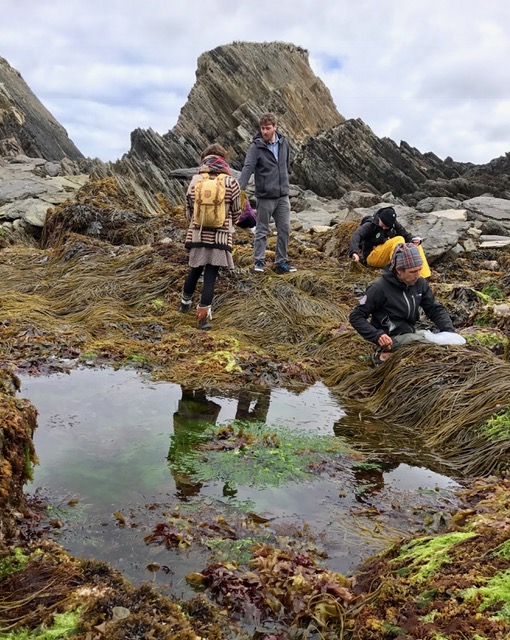I'm is Ireland now immersing myself in Irish Gaelic (one of the two official languages of the Republic of Ireland). The course is in Ballyferriter, on the Dingle Peninsula, and is three weeks long. Our weekends are free or have optional activities. I lhad the good fortune to find this adventure at the last minute.
Yesterday, Saturday, I joined an eight-hour class on seaweed. WHY? HOW BORING! You are thinking that - I can feel the waves of doubt. Ach, tá sé an-suimiúil! (But, it was very interesting!) Really. Check it out!
Armed with Wellies and eight layers of clothing, I met the group of eleven and we drove to a remote "beach." It was cold in the wind, but the eight layers of clothes did the trick.
Why do I say "beach"? Because it not there during high tide. This disappearing beach was only visible at low tide. It's there under the sea in the open rectangle of rocks.
High Tide
The new moon of two days ago had produced the largest tide of the month - a fifteen foot tide. When we arrived for our class a different sight awaited us. The beach had reappeared at low tide.
Low tide
Perhaps you're wondering how I got from the rocks, across the sea greens, to the small ponds. It's called "break-dancing"! It got easier after a while.
Darach, our instructor, explained some basic safety rules. About tides - the tidal range is the vertical difference between the high tide and the following low tide. Coastal tidal ranges vary typically from near zero to 38 ft. The rise and fall of this large or small amount of water occurs within the same time frame everywhere, so a large tide as much water pushes into the coast as a small tide,
SO set a timer so that you are not caught out on a disappearing beach. and listen for the increasing sound of water/waves. Also. don't. carry. your. harvesting. scissors. points. up!
Sea spaghetti was our first seaweed. Wow!
We learned how to harvest responsibly - take 1/16 or ⅛ of the plant. Don't harvest seaweed with reproductive bodies on it - let it reproduce!
After learning the characteristics of three types of seaweed, we were sent out to collect. Three more, repeat. We learned to identify and to harvest seven of the 600 varieties of seaweed found on Irish coasts.
Carrageen (Irish Moss)
The small black shells underfoot are mussels. They don't grow large in this area because their energy goes into hanging on to the rock as this area is so rough. We also saw limpets, periwinkles and sea urchins, but they weren't our focus.
Sea greens are in hand!
The incoming tide pushed us off the beach. AND IT WAS TEA TIME! Thank goodness! So we retreated to dry land where we had tea and an interesting talk on the use of seaweed in the garden. Wish I had some seaweed handy...
Next we sorted our communal stash - another great way to learn identification - and labeled each collection. We have sea spaghetti, dilisk, bladder wrack, serrated wrack, Irish moss, kelp, pepper dulse, alaria, and sugar kelp.
Time to cook! Six recipes, six cooking stations - we got cracking because we're hungry. A soup, two salads, hummus, veggie burger and cake! Seaweed in each recipe! Plus seaweed face cream thickened with carrageen. BTW, the cream is fabulous. I applied it to my sunburned face last night and today all is good. No pain, no redness, no wrinkles... Whopee!
My partner in cooking crime was Barbra (below) - we made a cake - and she's celebrating because the cake is in the oven! Our dinner site was not too shabby either- looking out at the ocean beyond.
All the dishes were tasty and delicious. There wasn't a bit of food leftover. Kudos to DArach for susch a wonderful experience! Kudos to my Irish instructor Caitríona for arranging this experience. Táim an-an-an-an-sasta! (verry,very,very happy)












No comments:
Post a Comment